Topwater Fishing For Bass
Anticipation, Exhilaration And An Adrenaline Rush!
Topwater fishing sounds like...Glurp, glurp, pause, glurp, WHAM,
SPLASH! Don't set the hook yet! Wait till you feel him! Now! There he
is. Stick him! Don't let him throw it! Easy now, easy, keep tension on
the line. Got him in the boat and he's a hawg! No need for more
coffee, at least for a while, because your heart is racing and your
hands shaking.
On a cool spring morning when the sun is just up, the air quiet and the water calm there is nothing better than this. Catching a bass on a topwater lure is truly a thing of beauty. To me, it's the Holy Grail of bass fishing.
Topwater fishing is generally thought of as producing best on warm, calm, shallow water on overcast days or during the low light periods of dawn and dusk. In reality, bass will hit topwaters any time of day and under many diverse conditions. So don't put them out of your mind when conditions don't meet the traditional thoughts on when to use topwater fishing lures.

The What, When and
Where of Topwater Fishing
"Water clarity" is a very strong element of successful topwater fishing because bass are sight feeders and the look and action of the lure, not the sound, will be the final determining factor if a bass strikes or not. Clear water is a very good place for topwater fishing stickbaits as they will draw big bass.
Topwater lures in general are well known for their ability to catch big bass after drawing them to the lure from a significant distance. There is a lake within 15 minutes of my house, Old Hickory Lake, where an eight pound largemouth was caught on a Zara Spook a few years back.
In off-colored water you should reach for noisy topwater lures. Buzzbaits, chuggers and prop baits are good examples.
Related to water clarity is "surface disturbance". Topwater fishing is impacted by the ability of a bass to see the lure, which is no small consideration when you're fishing for "sight feeders" like bass. To much surface disturbance limits this ability and correspondingly reduces the effectiveness of your topwater presentation. So while a small amount of surface movement is good, to much can be a bad thing.
Practically speaking, however,you will probably catch more bass, or at least have more activity topwater fishing, when the water has "some" surface movement to it, especially in clear water situations. Yes, the bass is a sight feeder and you want him to see your lure but you don't want him to see it so well he rejects it as "not natural".
"Water temperature" should certainly be a consideration when deciding which size topwater lure to use. It is understood that topwater fishing works "best" when water is over 60° which happens to also be right around the time spawn is ending. Most anglers do in fact delay topwater fishing until water temperatures reach the upper 60°'s.
When water is above 60° I always start with a topwater lure in the early morning. However, I always have topwater lures "on hand" and not including this in your bag at all times as a readily available technique is a mistake as bass can be caught on topwater lures even in 45° water.
Generally speaking, when water is cold to cool, the best topwater fishing lures to use are sleeker, smaller, minnow types such as:
- Smithwick Rogues®,
- Bomber® Long A's,
- Rebel Minnows,
- Lucky Craft's®
Gunfish and
- Rapala® Floating Minnows
These are what you should reach for when water temps are 55° to 65°. Use a bit slower retrieve in cooler water.
When water warms up above 65°, thicker or louder, more aggressive lures should be put to work. Lures like:
- the venerable Zara
Spook®,
- Rebel Pop-R's®, Storm™
- Chug Bug's® and
- prop baits like Smithwick's Devil Horse® are right for warmer water conditions.

"Which Topwater Fishing Lure Should I use?"
Though there are many different styles and shapes of lures, bass fishing topwater lures can all be included in the following categories: buzzbaits, chuggers, prop baits, minnow baits, stick baits and slop baits. When do you reach for which?
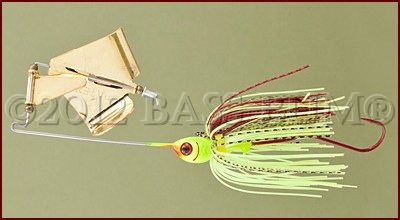
Buzzbaits - These topwater fishing lures are noise makers that come both large and small in size and all of which have a blade(s) which churns and sputters water as they are reeled across the water's surface. They have no inherent buoyancy and will sink if you stop retrieving them. For this reason they are "not" best for inactive bass which will quickly lose interest when it ceases to churn water.
Rods should be at least 6´ 6" to 7´ 6" long because this will facilitate long casts and the ability to maneuver the lure around stumps and logs. They also help greatly with long range hook sets. Line should be 14-20lb test monofilament. I use both baitcasting and heavy spinning gear for my topwater fishing. Use whatever works best in your hands.
Keep your rod high at the beginning of your retrieve slowly lowering it as the lure gets closer to your boat. A common mistake anglers make with buzzbaits is to retrieve them to quickly. Slower is usually better.
Buzzbaits are good in shallow water around laydowns or along grassy or pebble strewn shorelines.
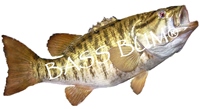
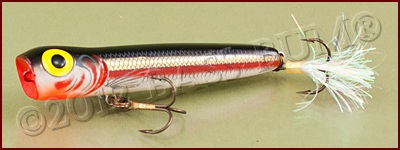
Chuggers - These lures and their close cousins, Poppers, feature a scooped out, cupped face which spurts out water when "chugged" (pulled forward). Some will have flattened or grooved faces. Many also have feather adorned rear treble hooks.
Use these for topwater fishing where bass are holding closely to a specific, confined area. After casting just past your target, let it sit for a short period. Then pop it a couple of times and again let it sit motionless for a few seconds. Don't move the lure forward more than 6-12 inches with each pop. Slowly retrieve it and attempt to keep it around your specific target area, a tree, stump, weed edge or rip-rap, as long as possible. This can tease inactive bass into taking it.
If you're more interested in covering water change your retrieve to continual rapid twitches with occasional pauses till the ripples subside. Then resume with rapid twitches for a distance before pausing again.
When you tie line to your lure be sure and and tie directly to the lure's nose ring. Using a heavy snap or clip attached to the nose ring can negatively affect the spitting action of the lure.
A baitcasting rod that is medium to medium-light action with 12-20lb monofilament line and 6´ 6" in length is a good choice for chuggers. The shorter rod allows for more pinpoint casting. During your retrieve hold your hod at about 10:00 and lower it as you bring the lure to the boat. A high speed baitcasting reel works well for chuggers. A spinning outfit with the same ratings is also appropriate. Use which ever rig best suits your personal style.

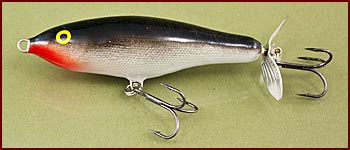
Prop Baits - As these lures are pulled across the surface propellers on one (tail-spins) or both ends create a ruckus to attract bass. They are a good choice for topwater fishing choppy water, on overcast days or even in rain.
Following bass into coves where they have followed shad and targeting them with a prop bait may give them a look they don't often see.
If you
see surface feeding bass "in the jumps" get only close enough to make as
long a cast as possible past the surface disturbance. Then retrieve
through it with with 2-4 foot pulls. A Devils Horse, which is a heavier lure than the one shown above, is a good choice for this.

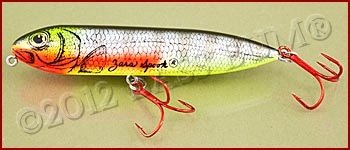
Stickbaits - Retrieve these lures correctly and you will impart a bass attracting side-to-side, zigzag sliding action to your lure. Since these topwater fishing lures have no intrinsic action any "life" it exhibits on retrieve is directly related to the manipulation of the lure by the angler. The right cadence, that is, the one which "walks the dog" in a manner that attracts bass, is determined by an angler's trial and error. This "right" cadence can change throughout the day as the conditions change.
Bass may think these lures are minnows as stickbaits have a reputation of calling up fish from depths of 20´. I've caught both large bass and very small bass on stickbaits though they're known mainly as big bass lures. As far as I'm concerned from my personal experience you can catch every size largemouth and smallmouth there is on these lures.
Since stickbaits don't spit or throw water they are at their best in relatively calm, clear to moderately clear water. Here in Tennessee I'll start fishing Spook's and Sammy's in the latter part of February targeting shallow points that have deep water close by. When bass begin moving into coves and pockets to spawn I target those areas focusing on submerged stumps, laydowns and weeds. After that I'll look to bluffs.
Stickbaits are usually made of plastic and are hollow with internal weights that cause their heads to float "up" slightly out of the water. This is what enables the lure to move side-to-side, or do what is called "walking the dog".
Stickbaits and "Walking The Dog"
Walking the Dog is best accomplished by pointing the rod tip down while retrieving the lure with short downward strokes and simultaneously turning the reel a quarter turn with each stroke. These downward strokes are followed by throwing slack into the line. The key is intermittently throwing slack in the line and then twitching it out rather than snatching the lure itself. You must give it some slack line so the lure can turn back freely. When you twitch the slack out of the line the nose of the lure swings to the opposite side. Make your cast, let it sit still till the ripples subside, then twitch - give slack - twitch - give slack over and over.
To walk the dog you make a long cast then start your retrieve with the rod raised to about 10:00 and use short twitches of the rod tip throwing slack line after each twitch. Drop your tip rod gradually dropped as the lure approaches the boat.
As for tackle, a 7´ medium action rod spooled with 10-15lb monofilament will allow you to make long casts and enable twitching of the tip to effectively work the lure. I use both spinning and baitcasting outfits for stickbaits. However, my preferred outfit is a 7´ Shimano Compre, medium-fast action rod spooled with 12lb monofilament coupled with a Shimano Calais 201DC reel.

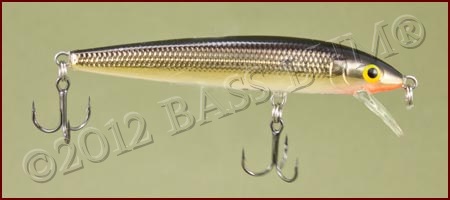
Minnow Baits - These lures are long and slender, made of balsa wood or plastic and equipped with a bill that allows them to be fished on or below the surface. They move with a tight back and forth shimmy that, when combined with their shape, gives a remarkably realistic impression of active baitfish.
The balsa versions of this lure are very effective for topwater fishing but casting them can be frustrating because they are so light weight. Genereally speaking, you will need light spinning gear spooled with only 8-10lb line for these. I use only spinning gear for fishing minnow baits whether they be wood or plastic. If you choose to use baitcasting gear use a lighter duty medium action 6´ to 6´ 6" rod rather than a heavy duty version. Be sure to tie your line to a snap or added O-ring attached to the nose ring and "not" directly to the ring as this will negatively impact their action.
When water reaches 50° the prime time for topwater fishing minnow baits has arrived and continues till spawn resuming again during post-spawn. Summertime is a good time to fish them over the tops of trees in which bass are suspended.
How Do You Fish Minnow Baits?
Minnow baits are sometimes called "twitch" baits because historically they have been fished with a "twitch and sit" retrieve. However, there are numerous ways to retrieve these lures. The following are retrieves I use.
Targeting stumps, rocks and weeds with a "steady retrieve" that takes the lure down 2-3´ and is then stopped next to the cover can be very effective. As the lure begins its slow ascent to the surface strikes often occur.
Deadsticking minnow baits after the cast, that is, allowing them to sit motionless for a period of time, has been very effective for me, especially around rocks, bluffs and even rip rap. Clear water, like what I find in Dale Hollow Lake, is necessary for this to be effective.
After casting and the ripples have subsided another technique is to sharply pop the rod tip which will pull the lure just under the water. Allow it to float back toward the surface and just as it gets there jerk it again. Repeat this over and over till you get a strike. This is good for targeting suspended bass.
Another retrieve is what might be called a "sweeping retrieve". Cast, reel up your slack and position your rod horizontal to the water's surface. Now sweep you rod with a slightly upward angle, not a level sweep. Do this with a rapid motion and it should cause the lure to move quickly forward. This is great for enticing strikes from bass on main lake points or flats.
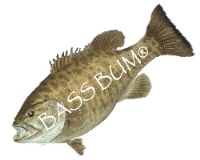
Soft Plastic Top Water Lures
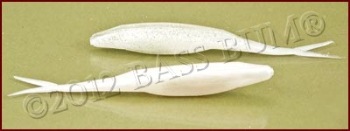
This topwater fishing category includes many styles of soft jerkbaits like Zoom Flukes (above), Yum Houdini Shads, Berkley Power Jerkshads, strike King's Z Too and the venerable Slug-Go.
They can be very effective over shallow grass, on flats and along bluffs when twitched just below the surface.
Rig these with a 4/0 offset, wide gap hook. I use a swivel attached 12" or so above the hook because I feel it reduces line twist. My leader is 1´ or 2´ of 100% fluorocarbon.
Double Rigs Double Your Pleasure, Double Your Fun
The past two years I began using a "double rig" and not only is it effective it's great fun to fish. I place a barrel swivel with a 12" leader and soft jerkbait attached onto my main line by running the main line through the eye of the swivel. I then tie on my routine barrel swivel to my main line and add my 24" leader and soft jerkbait. I use 4/0 hooks Texas style and no less than 12lb line. I've yet to get two on at the same time but that's my goal.
I don't use this topwater fishing rig just for schooling bass. I also fish it on flats and over grass with a strong, rapid jerk, jerk, pause retrieve. As for color, match the hatch.
Froggie Went A Courting and "Got Bit"!
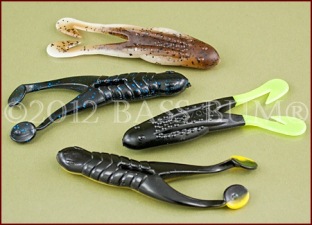
These fellows are sometimes called "slop baits" because they are fished over grass, lily pads, duckweed, milfoil and hydrilla. Hot weather, what some call the summer doldrums, is prime time for them. In the hot sun bass will retreat to the shade of grass and other vegetation where they wait in ambush for food to come to them. Look for spots to throw a frog where two different weed types merge, where there are any openings or holes in the mat surface, at the weed edge or where the weeds meet the shoreline.
How do you fish them? Cast the frog well past your target then hold the rod at the 2:00 position. This will keep the line off the mat. Retrieve the frog slowly across the grass mat or lily pads with intermittent pauses. When a bass blows up on the frog don't immediately set the hook, you'll miss him. Instead, lower your rod tip pointing it at the bass and take up slack. When you feel him on tight line, bust him with a strong upward stroke.
It's a fact that there are many bass missed when frog fishing. If you do miss immediately toss back to the same spot. If you miss again try a couple more times. If that doesn't work quickly toss a jig or worm where the bass was. They will often take these follow up baits.
Use a 7´ to 7´ 6" long medium-heavy baitcasting rod combined with a high speed reel. Line should be at least 20lb mono or braid. Flipping sticks also work well for this.
Return to Bass Fishing Techniques from Topwater Fishing
